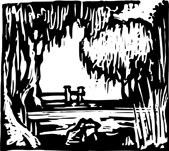
Image from Foto Search
It seems that Big Liz was quite a woman, so much so that her legend takes on all kinds of twists and turns. It was never exactly the same in any retelling. But here's our version:
Big Liz was a slave woman who was owned by John Rustin, a Confederate fundraiser and owner of a Bucktown tobacco plantation on the Maryland Eastern Shore in southern Dorchester County.
It was obvious why she was called Big Liz - she was a huge, powerful woman, robust and strong from long days of toiling in the fields. And she most certainly did not share the political views of her master.
The boss thought she was a Union spy working with local collaborators, tipping off shipments of gold sent out from the plantation to pay the reb troops and even spilling the beans as to where his treasure trove was, hidden in the barn.
Rustin had to get rid of Big Liz and her big mouth, but he knew he couldn't take her physically mano a mano. Killing two birds with one stone, he had her carry the heavy gold chest to the nearby Greenbriar swamp and bury it. As a weary Big Liz was covering the strong box with a last shovelful of muck, Rustin struck.
He beheaded her with one mighty swipe of a foot-long tobacco knife.
Rustin buried her body in the swamp without her head, which had rolled away in the darkness. Big Liz's vengeance wouldn't wait to be served cold. It's said that he met his fate that same evening, frightened to death in his bedroom by a midnight visit from a zombie-like Liz, head tucked under her arm.
Fitting end, you say? Not quite. It's believed that Big Liz has never left the scene of her murder.
The DeCoursey Bridge crosses the serene Transquaking River as it meanders through the marshes. And if you want to meet the legend, at least in spirit, park on the bridge, turn off your car, honk your horn three times (others say you have to flash your headlights while beeping; apparently it's a pretty ritualized ceremony), and wait.
Big Liz’s presence will manifest itself. Some claim she comes as a glowing orb, or can be heard making a low, moaning sound. But the lore we prefer is that Big Liz will appear holding her head in her hands. If you follow her she will lead you through the trees and mud to where the wealth is hidden.
But no one has had the courage to follow her yet...because another piece of the legend is that Big Liz still haunts the area where the gold was buried. It cost Liz her life, and no one is going to take it from her - ever.



